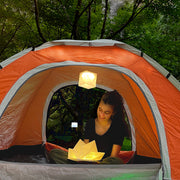Packing for your Hiking Trip

Packing for a hiking trip can be overwhelming, especially if you're new to the activity. But with the right preparation and gear, it can be a truly rewarding experience. One of the most important aspects of preparing for a hike is packing your backpack correctly. In this post, we'll go over the essentials of how to pack a hiking backpack, including the different types of backpacks, what to pack, and why it's important to bring these items.

Types of Hiking Backpacks
Before you start packing, you'll need to choose the right backpack for your hike. There are three main types of hiking backpacks: daypacks, overnight backpacks, and multi-day backpacks.
Daypacks are small backpacks that are designed for short hikes lasting a few hours. They typically have a capacity of 10-30 liters and are perfect for carrying essentials like water, snacks, and extra clothing layers.
Overnight backpacks are designed for overnight trips and have a capacity of 30-50 liters. They can hold enough gear for one or two nights, including a tent, sleeping bag, and cooking supplies.
Multi-day backpacks are the largest type of hiking backpacks and are designed for trips lasting three or more days. They typically have a capacity of 50-80 liters and can hold everything you need for a long trip, including a tent, sleeping bag, cooking supplies, and extra clothing.
What to Pack
Once you've chosen your backpack, it's time to start packing. Here's a list of essential items to bring on your hike:
Navigation
- Map: Bring a detailed map of the area you'll be hiking in.
- Compass: A compass is essential for navigation, especially if you're hiking in an area without clearly marked trails.
- GPS device: A GPS device can be helpful for tracking your progress and ensuring you're on the right path.
- Whistle: A whistle can be used to signal for help if you get lost or injured.
Sun Protection
- Sunscreen: Protect your skin from the sun's harmful rays by applying sunscreen with an SPF of at least 30.
- Sunglasses: Sunglasses will protect your eyes from the sun and reduce glare.
- Hat: A wide-brimmed hat will provide shade and protect your face and neck from the sun.
Insulation
- Extra clothing layers: Bring extra clothing layers, including a warm jacket, to stay warm in case of cold or wet weather.
- Rain jacket: A rain jacket will keep you dry in case of rain or wet weather.
-
Fleece jacket: A fleece jacket is a good mid-layer for staying warm in cold weather.

Illumination
- Solar lanterns: These lanterns are lightweight, packable, and solar-powered. Try Solight Design’s Solarpuff lanterns.
- Headlamp: A headlamp will provide hands-free illumination for hiking in the dark.
First Aid
- First aid kit: A first aid kit should include items such as bandages, gauze, antiseptic, and pain relievers.
- Medications: Bring any necessary medications, such as an EpiPen or inhaler.
- Insect repellent: Insect repellent will help prevent bug bites and stings.
Repair Kit and Tools
- Multi-tool: A multi-tool can be used for a variety of tasks, such as cutting rope or fixing gear.
- Duct tape: Duct tape is a versatile tool that can be used for repairing gear or making makeshift bandages.
- Sewing kit: A small sewing kit can be used for repairing clothing or gear.
Nutrition
- Water: Bring plenty of water to stay hydrated during your hike.
- Snacks: High-energy snacks such as trail mix or energy bars can help keep you fueled during your hike.
- Meals: Bring lightweight, high-energy meals such as dehydrated backpacking meals.
Hydration
- Water bottles: Bring water bottles or a hydration system, such as a hydration bladder.
- Water filter or purification tablets: If you'll be drinking water from natural sources, bring a water filter or purification tablets to ensure the water is safe to drink.
Emergency Shelter
- Tent: A lightweight tent can provide shelter in case of an emergency or unexpected weather.
- Tarp: A tarp can be used as a makeshift shelter or to cover gear in case of rain.
- Bivy sack: A bivy sack is a lightweight, waterproof shelter that can be used in emergency situations.
Fire
- Lighter or matches: Bring a lighter or matches for starting a fire in case of emergency or for cooking meals.
- Firestarter: A firestarter, such as waterproof matches or a firestarter stick, can be used to start a fire in wet conditions.
Remember to adjust your packing list based on the length and difficulty of your hike, as well as the weather and terrain you'll encounter. With the right gear and preparation, you'll be ready for a safe and enjoyable hiking trip.
Why It's Important to Bring These Items
Bringing these items is important for several reasons. Navigation tools will help you stay on track and avoid getting lost. Sun protection will help prevent sunburn and heat exhaustion. Insulation will keep you warm and dry in case of cold or wet weather. Illumination will help you see in the dark and signal for help if needed. A first aid kit will help you treat injuries and illnesses on the trail. Repair kit and tools will help you fix gear that breaks or malfunctions. Nutrition and hydration are essential for providing your body with energy and hydration. Emergency shelter will keep you safe and dry in case of an emergency. And finally, fire will provide warmth and help you cook meals.
Conclusion
Packing your backpack correctly is essential for having a successful and enjoyable hiking trip. By choosing the right backpack, packing the right gear, and knowing why it's important to bring these items, you'll be well on your way to a safe and comfortable adventure in the great outdoors.






Leave a comment